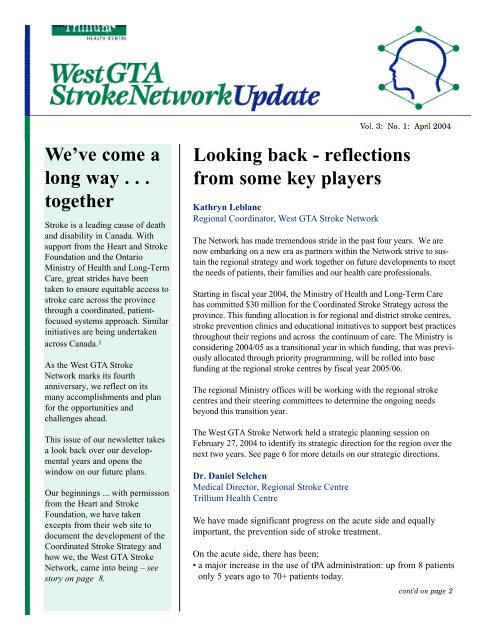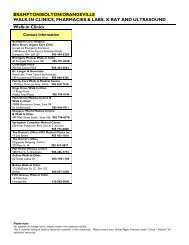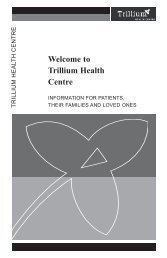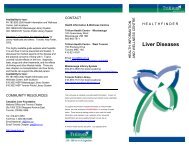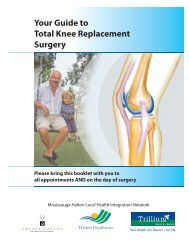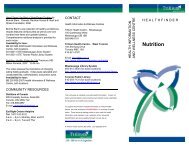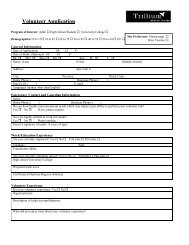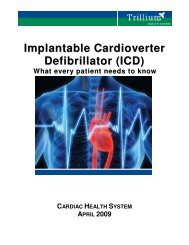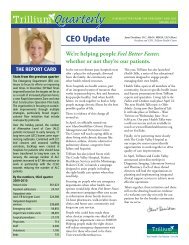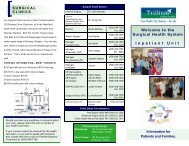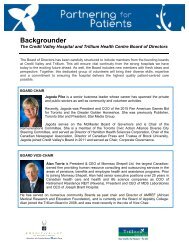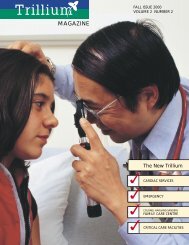We've come a long way . . . together Looking back - reflections from ...
We've come a long way . . . together Looking back - reflections from ...
We've come a long way . . . together Looking back - reflections from ...
- No tags were found...
Create successful ePaper yourself
Turn your PDF publications into a flip-book with our unique Google optimized e-Paper software.
Vol. 3: No. 1: April 2004We’ve <strong>come</strong> a<strong>long</strong> <strong>way</strong> . . .<strong>together</strong>Stroke is a leading cause of deathand disability in Canada. Withsupport <strong>from</strong> the Heart and StrokeFoundation and the OntarioMinistry of Health and Long-TermCare, great strides have beentaken to ensure equitable access tostroke care across the provincethrough a coordinated, patientfocusedsystems approach. Similarinitiatives are being undertakenacross Canada. 1As the West GTA StrokeNetwork marks its fourthanniversary, we reflect on itsmany accomplishments and planfor the opportunities andchallenges ahead.This issue of our newsletter takesa look <strong>back</strong> over our developmentalyears and opens thewindow on our future plans.Our beginnings ... with permission<strong>from</strong> the Heart and StrokeFoundation, we have takenexcepts <strong>from</strong> their web site todocument the development of theCoordinated Stroke Strategy andhow we, the West GTA StrokeNetwork, came into being – seestory on page 8.<strong>Looking</strong> <strong>back</strong> - <strong>reflections</strong><strong>from</strong> some key playersKathryn LeblancRegional Coordinator, West GTA Stroke NetworkThe Network has made tremendous stride in the past four years. We arenow embarking on a new era as partners within the Network strive to sustainthe regional strategy and work <strong>together</strong> on future developments to meetthe needs of patients, their families and our health care professionals.Starting in fiscal year 2004, the Ministry of Health and Long-Term Carehas committed $30 million for the Coordinated Stroke Strategy across theprovince. This funding allocation is for regional and district stroke centres,stroke prevention clinics and educational initiatives to support best practicesthroughout their regions and across the continuum of care. The Ministry isconsidering 2004/05 as a transitional year in which funding, that was previouslyallocated through priority programming, will be rolled into basefunding at the regional stroke centres by fiscal year 2005/06.The regional Ministry offices will be working with the regional strokecentres and their steering committees to determine the ongoing needsbeyond this transition year.The West GTA Stroke Network held a strategic planning session onFebruary 27, 2004 to identify its strategic direction for the region over thenext two years. See page 6 for more details on our strategic directions.Dr. Daniel SelchenMedical Director, Regional Stroke CentreTrillium Health CentreWe have made significant progress on the acute side and equallyimportant, the prevention side of stroke treatment.On the acute side, there has been:• a major increase in the use of tPA administration: up <strong>from</strong> 8 patientsonly 5 years ago to 70+ patients today.cont’d on page 2
Where We Are Now . . .(cont’d <strong>from</strong> page 1)• the implementation of the repatriation agreementthat facilitates prompt treatment to residents <strong>from</strong>across the community. Larger numbers ofpatients are being treated and their recoverypotential is greatly improved.• the Comprehensive Stroke Unit offers patientsacute and early rehabilitation treatment <strong>from</strong>the same hospital bed;• the availability of neurointerventionaltreatment with intraarterial tPA, under thedirection of Dr. Dominic Rosso. “No one else inthe region has the capability to offer this highlyinvasive treatment process. This is the wave of thefuture – giving us (clinicians and patients) a<strong>long</strong>er window of opportunity for treatment.”• the Stroke Prevention Clinic offers rapid access(2-3 days) to testing and assessment for individualswho have experienced minor strokes/TIAs –and “prevents bad things <strong>from</strong> happening.”“Our goals are modest - we are not expecting tocure all those with stroke,” says Dr. Selchen. “If weprevent 15-20 ‘disasters’ a year, it will be worthwhile.A bad stroke is an ongoing catastrophe, andis devastating for the patient and the family.”Mary LewisSr. Manager, Government RelationsHeart and Stroke Foundation of OntarioA strong advocate for the coordinated stroke strategy<strong>from</strong> the outset, Mary Lewis believes that theWest GTA Stroke Network has al<strong>way</strong>s been a leaderand that it has made a significant contribution toevolution of the Ontario Stroke Strategy.“Two areas stand out,” she says. “One was developingthe best practice guidelines and care guidesacross the continuum of care. The West GTA teammade a huge contribution to Best PracticeGuidelines for Stroke Care, particularly with respectto transition management and community reengagement.Secondly, West GTA was out front oneducation, using an early opportunity to demonstratethe value of a Regional Educator. Linda Kello<strong>way</strong>,and others in West GTA, have led the <strong>way</strong> indeveloping regional educational opportunities andhelping build province-wide resources.”Scott McLeodDirector of PlanningHalton-Peel District Health CouncilBeing actively involved in the evolution of theOntario Stroke Strategy, Scott McLeod has watchedthe development of the West GTA Stroke Networkclosely. He acknowledges the success of this particularNetwork, stating that it is absolutely a successand he praised Trillium Health Centre for its commitmentto bringing the Regional Stroke Centre intobeing. He also gives credit to regional coordinator,Kathryn LeBlanc, as a driving force behind thegrowth and development of the Network, for herleadership and for influencing other area networks.Success also brings about challenges, particularly inan area where the demographics of the population isgrowing and aging rapidly, such as in Peel andHalton. “Managing everything associated with theprogram will be a definite challenge,” says Mr.McLeod. “Capacity will need to be ramped up at allsites to meet the needs over the next few years -acute, rehab and community resources are all scarce.”According to Mr. McLeod, other challenges facingthe Network include the need for an effective datacollection system, having resources to supportongoing education throughout the region, and ensuringthat care across the continuum is maximized.Chris PowerVice President Patient ServicesTrillium Heath CentreChris Power’s unique perspective on the Networkreflects her move to Ontario in 2003. She has beenimpressed with the work of the Network (havingwatched Nova Scotia struggle with similar issues), aswell as the high level of involvement within the We s tG TA Network and its level of leadership capability.“At Trillium, we are fortunate to have two regionalcont’d on page 4
A Patient’s Perspective – Day Hospital Gives HopeThe words of Rehab DayHospital patient, Chen-HuaHuang, tell their own story of theimpact of a stroke and the abilityof our team players to improvethe quality of life of strokesurvivors.Chen-Hua Huang experienced astroke in July, 2003 and has beena patient in the Rehab DayHospital at Trillium sinceSeptember, 2003. With the helpof the interdisciplinary team andhis devoted wife, Chen has madesignificant progress in therapy.He volunteered to share his storyand his thoughts about the DayHospital program.speech and swallowing. Now Ican drink coffee, tea, eat pizza. Ican go to restaurants. I don’tdrool anymore.When I came to the Day HospitalI could not sit or stand. But nowI’m going to buy my cane. I amlearning how to climb stairs so Ican go to Ottawa to see my twoyear-oldgrandson. I can get outof bed myself and bend to put onmy shoes without falling.I never used to turn my head tothe left. I learned to turn my headso now I can play the stockmarket, read and write. I getrecipes off the internet. When Icame I did not want to talk. Iwas depressed and had problems.Now I talk to everybody. I playbridge, mahjong and go to theStroke Recovery Program.My wife learned a lot and gotsupport <strong>from</strong> the staff, thefamilies, and the patients.You have saved my life. Youhave given me hope. Thank you.”“Before I had my stroke I wasvery active. Never home. I hadmy stroke July 11, 2003. I had(inpatient) rehab for seven weeks.When I came to Day Hospital Iwas very depressed and verysick. I was afraid to sleep in caseI did not wake up.The nurse taught me about bloodpressure and how to stop a strokeand I could sleep again. I couldnot swallow and had problemswith my speech. The speechtherapist helped me with my“You have given me hope. Thank you,” says Chen-Hua, seen herewith the Rehab Day Hospital team.Trillium Health Centre’sRehabilitation Day Hospitalis an interdisciplinary outpatient program servingadult patients <strong>from</strong> Peel, Halton and West Toronto.Originally a general rehabilitation program, theprogram has be<strong>come</strong> increasingly specialized in thelast six years, and currently focuses solely onneurological rehabilitation. Patients served by theDay Hospital include individuals who have experiencedstrokes, aneurysms, acquired brain injuriesand degenerative neurological conditions. Referralsare received <strong>from</strong> inpatient units at Trillium (i.e. thecont’d on page 6
Reflections(cont’d <strong>from</strong> page 2programs (cardiac and stroke). It fosters recruitmentof the best of the brightest of health care professionalswho bring their leadership and expertise.However, this also poses challenges with risingcosts and funding pressures as drugs, equipmentand patient volumes increase.”Ms. Power also recognizes that demographics withinthe region will put pressure on the program, aswill maintaining the momentum, and facing newand competing priorities.Paul StonerOperations ManagerMississauga Central Ambulance CommunicationsCentre, Emergency Health Services, MOHLTCPaul Stoner sees the signing of the bypassagreement as a major accomplishment of theNetwork. “It has be<strong>come</strong> a template for similaragreements and it appears to be working very well.Our paramedics cover a wide geographic area andfollow very specific protocols when dealing withstroke patients, and we know that patient out<strong>come</strong>sare improved.”The possible downside of the agreement, and achallenge yet to be resolved, is the timely transfer ofpatients <strong>back</strong> to their home communities, which isimpacted, for various reasons, by the availability ofbeds and patient transportation services.Sandra Shaw and Meredith UngaraPatient Care ManagersWilliam Osler Health CentreBoth managers have experienced the benefits ofenhanced clinical educational opportunities andfunding that have been offered through the Network,for themselves and their staff.“Education and best practice guidelines, thecollaboration, the sharing of experiences andnetworking between colleagues and facilities, haveall contributed to improved clinical care. Staffbe<strong>come</strong> energized when they see results.” They alsoacknowledge the skills and knowledge of LindaKello<strong>way</strong>, Regional Stroke Educator, “who is atremendous resource to us.”Being part of regional research projects is anotheradvantage of Network partnership, giving front-linehealth care professionals the opportunity to share inthe improved patient out<strong>come</strong>s and practice development,as well as keeping everyone current.Both believe that increased communication of theNetwork’s successes will benefit others. “We needto be sharing our experiences more, so others don’thave to re-invent the wheel.” They also see theneed for benchmarks for monitoring and evaluatingprograms; increased emphasis on stroke preventionmore community-based after-stroke programs, andongoing support and funding for continuingeducation and research.Mark Your CalendarsMonday, September 27, 2004Best Practices SymposiumToronto - location to be announcedFunded by the MOHLTC OntarioStroke Strategy and hosted by thefour Regional Stroke CentresFor physicians, nurses, rehab professionalsworking with stroke patients who are interestedin the latest evidence-based practices instroke care and the 19 provincial strokeguideline recommendations
Where We Are Now in 2004 –the challenges and opportunitiesThis summary of the status ofthe Network was presented tokey stakeholders who met inFebruary 2004 to plan futuredirections. (See page 6).Milestones to date• stroke protocol/path<strong>way</strong>s/guidelines – standarduse in hospital settings• identified clinical leadersand committed resources• clustering of stroke patientsin acute care; specializedregional unit established atRSC• reduced LOS in acute caresettings• stroke expertise developingin rehab settings• formalized educationopportunities• regional ambulance redirectand repatriation forischemic stroke patientstreated with tPA• Stroke Prevention Clinicestablished with significantreferrals <strong>from</strong> familyphysicians throughout theregion and <strong>from</strong> ER’sChallenges• Human resource pressures• Data management• Documentation• Rehabilitation• RSC operational pressures• PreventionOpportunities• Leveraging with GTA-wideand provincial initiatives tocreate momentum for newdevelopments in strokerehab• Utilizing technology toroll-out education, clinicalconsultations• Building and supporting“expert” teams/resourcesthroughout the region• Evolving the strategy andimplementing best practicesin community, CCAC andLTC sectors• Development of strokeprevention satellite serviceswith allocated diagnosticsupportComprehensive Stroke Unit - tPA Statistics706050403020100Period1 - April 2000-March 2003 = 36 pt2 - April 2001-March 2002 = 34 pt3 - April 2002-March 2003 = 49 pt4 - April 2003 to Jan. 2004 = 65 ptSince June 2001, 41% of tPArecipients were by-passed <strong>from</strong> oneof the regional hospitalsHow We Match UpWith MOHLTC - OSSMonitoring andEvaluation InitiativeAccess – Care is provided withthe appropriate level of expertise,at the appropriate location, withthe appropriate technology, in atimely manner consistent withbest practices.Integration – Linkages betweencare providers to achieve theseamless delivery of servicesacross local, regional andprovincial jurisdictions and withinand between organizations.Out<strong>come</strong>s – Impact of clinicalcare on clients; extent to whichoverall goals and principles of thestroke strategy are achieved.Achieving identified bestpractice targets for patient accessto regional prevention services.Client and ProviderP e rceptions – Extent to whichstroke system meets people’sexpectations (clients, families,caregivers and providers)– currently under development.Research and Innovation –Exploration of evidence-basedpractices, documentation ofeffective dissemination of resultsand adoption of best practices inthe delivery of stroke care– ongoing need.For additional information,please contact Kathryn LeBlanc,Regional Coordinator at905-848-7580 x 5476
Rehab Day Hospital(cont’d <strong>from</strong> page 3)Comprehensive Stroke Unit),other hospitals, and professionalsin the community.Initially, patients participate inan interdisciplinary assessmentduring which time the patient,family and all Day Hospital teammembers jointly determine thepatient’s impairments. In discussionwith the patient and family,rehabilitation goals are establishedand it is decided whichdisciplines will be required tohelp meet therapeutic goals.The Day Hospital team consistsof an occupational therapist,speech-language pathologist,physiotherapist, social worker,recreation therapist, occupationaltherapy assistant, physiotherapyassistant and two nurses.Following the team assessment,patients attend the program twiceweekly and receive varioustherapies throughout the day.Length of stay is determined onthe basis of progress, but it is3-6 months on average. TheRehabilitation Day Hospital hashelped many patients achievefunctional gains and helpedthem to return to enjoyable,independent living after neurologicalevents.For referrals or additionalinformation, please contact theRehab Day Hospital, TrilliumHealth Centre at 905-848-7280.Story submitted by DarienHeathcote, speech-languagepathologist, on behalf of theRehab Day Hospital Team.Strategic Directions for 2004 – 2006Here is the framework for the future direction of the Network,developed on February 27, 2004. More detailed information isavailable <strong>from</strong> Kathryn LeBlanc, Regional Coordinator, at905-848-7580 x 5476.VISION 2006By the end of 2006, we want to see that clients in our catchmentarea receive the right treatment or therapy at the right place andat the right time – based on best practices using the appropriateresources. We also want to see that the delivery of services tostroke victims and their families is equitable across the Provinceand we will take a leadership role in achieving that end.Strategic FocusIn order to achieve our Vision, we are committed to the followingStrategic Priorities• Enhance PreventionTo ensure that acute risk patients are seen within 2-3 days andpatients with more general risk are seen within 1-2 weeks. Themodel to provide this level of service would be a ‘hub-and-spoke’with the regional stroke centre at the hub.• AdvocacyTo ensure that services for individual stroke survivors and theirfamilies are available across the continuum of care.• Improved TransitionsTo ensure that there is a smooth transition through the carecontinuum <strong>from</strong> pre-hospital, acute care and return to thecommunity. These transitions must flow fairly and equitably inboth directions across the region.• TransportationTo work with regional stakeholders to address impediments transportationposes to ensuring patient access across the continuum.• Education & CommunicationTo promote patient/family education that offers appropriateinformation to assist in stroke recovery;To ensure ongoing evidence-based, best practice education forhealth care professionals• Contingency PlanningA contingency plan for the Network will be completed andapproved by the Steering Committee by August 2004.
“Saving the Brain From Stroke” –Continuing Education for Family PhysiciansThe World Health Org a n i z a t i o nestimates 5.54 million strokedeaths worldwide/year, thesecond most common cause ofm o r t a l i t y. With the populationaging the incidence of strokewill likely increase over thecoming years, hence the primarycare physician will likely havean increasingly important role inboth primary and secondarystroke prevention.With this in mind, the “ S a v i n gthe Brain <strong>from</strong> Stro k e ”program was developed to helpprimary care physiciansre-evaluate their current practiceand update their knowledge onthe prevention and managementof stroke"This educational program,initially designed for smallgroup workshop sessions, hasbeen accredited by the Collegeof Family Physicians forMainpro 1 and C credits. Thedevelopment of the workshopwas a collaborative effortbetween primary care andspecialist physicians interestedin the prevention and managementof stroke, the Universityof Ottawa and la Fédération desMédecins Omni-practiciens duQuébec (FMOQ).Dr. Andre Douen, Neurologist,Trillium Health Centre,<strong>together</strong> with Dr. Sol Stern,Family Medicine and Chief ofStaff at the Halton HealthcareServices, and Dr. Marcel Dore,Family Physician, Guelph,formed the nidus around whicha core planning committee andnational planning committeewere formed.The development andimplementation of the initialeducational workshop wasgenerously sponsored throughan unrestricted educationalgrant <strong>from</strong> Aventis Pharma,with special contributions <strong>from</strong>Jill Donahue and Bob Chesterof Aventis’s Department ofProfessional Education.Web-based EducationMore recently, Drs. Douen,Stern and Dore, in collaborationwith the University ofOttawa and MemorialUniversity have transformedthe stroke workshop into aweb-based program that willhopefully allow access ofthe course to many morephysicians across the country.Living With StrokeThe focus of the programremains essentially the same:to review and synthesizepertinent data <strong>from</strong> largeclinical stroke trials andincorporate this information inpractical case-based scenarios.Every effort has been made toprovide the best availablemedical evidence at the time ofproduction. This comprehensiveand exciting educationalprogram challenges primarycare physicians to re-evaluatetheir current practices andupdate knowledge and skills onthe prevention and managementof stroke. More importantly, itis relevant to everyday clinicalpractice.For more information,pleasecontact:Dr. Andre Douen at:adouen@thc.on.ca orDr. Sol Stern at:sstern@haltonhealthcare.on.ca• Gain valuable insight into the effects and causes of strokes;prevention, treatment, and useful coping strategies.• Meet, in a small group setting, to share experiences with thosedealing with the same challenges that you are.• Six-week program designed for families and stroke survivorsregardless of time or severity of the stroke.Halton Hills Speech Centre, GeorgetownFor more informationcall 905-873-8400 or 1-877-645-0460A Heart and Stroke Foundation of Ontario program
The Building Blocks of the West GTA Stroke NetworkCoordinated Stroke Strategy(CSS)The Coordinated Stroke Strategywas a three-year systems changeproject that began in 1998.The overall goal of the strategywas to ensure that all Ontarianshave access to the best possiblestroke care. The strategy involvedfour Ontario demonstration sites(one being the West GTA) to testa model of region-wide strokecare that spans the continuum ofcare. There are three majorcomponents of the CoordinatedStroke Strategy, systems change,public awareness and professionaleducation.The original West GTA groupconsisted of Humber RiverRegional Hospital, William OslerHealth Centre, St. Joseph's HealthCentre, Trillium Health Centre,West Park Healthcare Centre andCCACs for the area.The <strong>back</strong>ground and evaluationresults of the demonstrationproject can be viewed online at underProvincial Initiatives – Historyand Evaluation. 1One of the most significantinitiatives within the CSS,occurred when the HSFOconvened a Stroke RehabilitationConsensus Panel. These strokesurvivors, physicians, nurses,rehabilitation professionals, andcommunity representativesworked to develop a frameworkof how stroke rehabilitationservices should be provided inOntario based on the currentevidence. 2Ontario Stroke Strategy(OSS)Building on the CSS, theMOHLTC’s Ontario StrokeStrategy (OSS), a comprehensiveStroke Strategy across thecontinuum <strong>from</strong> prevention torehabilitation, was developed.Towards an Integrated StrokeStrategy 3 was released in June2000. This report is a roadmapfor stroke care in Ontario andincludes 15 recommendations forstrengthening prevention effortsand establishing a coordinatedsystem of stroke care.The shift <strong>from</strong> four demonstrationprojects (CSS) to a mandatedprovincial initiative (OSS), providesan interesting opportunityto learn more about the successfuldevelopment of coordinatedregional stroke care delivery. InFebruary 2001, the MOHLTCdesignated the first six regionalstroke centres for Ontario,including Trillium Health Centrefor the West GTA region.These centres are responsible formanaging acute stroke care,developing secondary preventionclinics, providing leadership inthe development of a rehabilitationservice delivery system andsupporting training initiatives forhealth care providers.References:1. Heart and Stroke Foundation web site 2. Report of the Stroke Rehabilitation Consensus Panel (2000). Toobtain a copy, email CSS@hsf.on.ca or call (416) 489-7111 x 456.3. Towards an Integrated Stroke Strategy (June 2000)Items 2 and 3 can be accessed online at:Publication DeadlinesNetwork partners are encouraged to submit articles for this newsletter showcasing theachievements, research and activities of their facilities. Submission deadlines for thenext issues are July 15, October 15, 2004 and January 15, 2005 respectively. Pleaseforward items to Maria Atzori, West GTA Stroke Network at matzori@thc.on.ca.West GTA S t roke NetworkA consortium of six hospital centres (CreditValley Hospital, Halton Healthcare Services,Headwaters Health Care Centre, TrilliumHealth Centre, West Park HealthcareCentre and William Osler Health Centre);plus the Community Care Access Centres ofEtobicoke-York, Halton and Peel; the Heartand Stroke Foundation of Ontario; theMinistry of Health and Long-Term Care;and Halton-Peel District Health Council, theNetwork’s goal is to implement a coordinatedapproach to stroke care throughout the WestGTA region.Funding for the Ontario Stroke Strategyis provided by the Ministry of Health andLong-Term Care.


